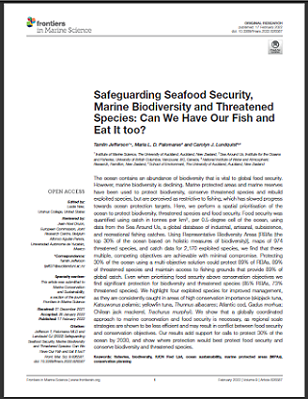
The ocean contains an abundance of biodiversity that is vital to global food security. However, marine biodiversity is declining. Marine protected areas and marine reserves have been used to protect biodiversity, conserve threatened species and rebuild exploited species, but are perceived as restrictive to fishing, which has slowed progress towards ocean protection targets. Here, we perform a spatial prioritisation of the ocean to protect biodiversity, threatened species and food security. Food security was quantified using catch in tonnes per km2, per 0.5-degree cell of the ocean, using data from the Sea Around Us, a global database of industrial, artisanal, subsistence, and recreational fishing catches. Using Representative Biodiversity Areas [RBAs (the top 30% of the ocean based on holistic measures of biodiversity)], maps of 974 threatened species, and catch data for 2,170 exploited species, we find that these multiple, competing objectives are achievable with minimal compromise. Protecting 30% of the ocean using a multi-objective solution could protect 89% of RBAs, 89% of threatened species and maintain access to fishing grounds that provide 89% of global catch. Even when prioritising food security above conservation objectives we find significant protection for biodiversity and threatened species (85% RBAs, 73% threatened species). We highlight four exploited species for improved management, as they are consistently caught in areas of high conservation importance (skipjack tuna, Katsuwonus pelamis; yellowfin tuna, Thunnus albacares; Atlantic cod, Gadus morhua; Chilean jack mackerel, Trachurus murphyi). We show that a globally coordinated approach to marine conservation and food security is necessary, as regional scale strategies are shown to be less efficient and may result in conflict between food security and conservation objectives. Our results add support for calls to protect 30% of the ocean by 2030, and show where protection would best protect food security and conserve biodiversity and threatened species.












